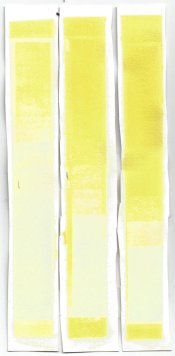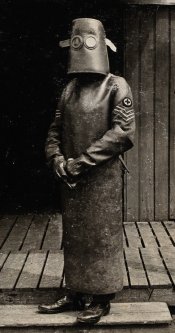So today i thought i'd start working towards a multiple layer print, but it seems things didn't want to go my way.
I did a few of test strips to try and figure out an exposure time, the gum/pigment/dichromate mix i used was the same as what Bob mentioned, but in a smaller amount. The only difference was i used 13% potassium dichromate rather than 10% ammonium dichromate. I assumed (possibly incorrectly) the only impact this was likely to have was on the exposure time.
I printed a clear to black in 10% steps scale on OHP film and did 3 exposures, 30, 60 and 90 seconds.
As you can see, there is a very narrow range of tones and a lot of flaking on the mid tones.
You'll have to forgive the horrific quality on my scanner, i've no idea where it got the blue tinge from!
I am not a good person to trouble shoot someone else work in a different darkroom, but I can give you some guidance on how I trouble shoot gum. I learned a lot of this
the hard way by wasting a lot of paper and time, but the single most important thing is don't give up.
First off I bought Christina Anderson's book , and I downloaded Stephen Livik manual on gum.
I read both of these items twice.
I tried to use pigments that were recommended, Keith Taylor another gum printer recommended three pigments in the Daniel Smith line and I used them with success.
In their writings they give starting points and recommendations which are only that starting points for you to print from.
They also will give trouble shooting guides, but be warned language is a funny thing and you could be interpreting their words wrong and spending a lot of time .. Flacking - Fisheyes- Round density
are three that gave me particular problems.
As you can see from your test strips the exposure latitude with gum is wide , and the number of step tablets you can see is much less than silver or pt pd, and you should use this to your advantage and pick originals
that will compliment rag paper and muted tones- as compared to ink jets... remember if I want perfect colour density and contrast I would not waste my time with gum but do ink jets and be done with it.
P Dichromate vs A Dichromate - I found a big difference when I tested so I use A Dichromate.
Water - I find this to be very important and I switched to Distilled for the first bath.
Process time, I found different pigment loads and end results will cause different times
Pigment load , I found more pigment = stain
More Gum= quicker wash off
PVA - had no effect
Sizing paper had no effect
Pre Shrinking had incredible effect on future registration
Fast Even coating had better effect rather than painfully slow coating
Face down Development did not create fish eyes-
Incredible agitation when mixing coating did not create fish eyes
Incredible agitation when mixing speed up the process
Incredible agitation when mixing gave a weaker colour density , but by increasing pigment and A Dichromate over came this a bit.
Many papers work very well... Arches Platine-Hannamuhle Platinum Rag-Cot 320- Reverre - all work equally well in my darkroom for pt pd and gum.
Last water bath is most critical and should be careful and light the tray - have your brushes here and a slow stream of water , this is where the magic can happen.
You must agitate the print when first in distilled water a bit so there are no air pockets which will cause plus density.
Turn off lights while paper is drying , seems to work for me
Potassuium MetaBisulfate in my darkroom does not give the magic last cleansing both Christina A and Stephen L talk about.
Water quality is top on my list as potential problems , mineral content
temperature should be room and never change this unless you have a specific reason
Humidity for gum seems to work well at around 40%
re read you books every third month, it will be funny how things start making sense.
Do not change a bunch of factors at once - change only one thing so you actually can narrow down.
You should understand all you can about the pigment line and Daniel Smith offers a chart that tells you what each pigment # exhibits and funny each other line of Manufacturers have the same #
for example I have used Thaylo Blue green shade in both Daniel Smith and Windsor Newton with no difference.
Understanding that some pigments are opaque or semi transparent will make a big decision on when the get laid down.
Figure a way to see how all the pigments look and pick the ones you like and stick with them.... your step tablet is a good idea but personally I prefer to see images.
Gum can be liberating for an artist as you can coat , walk away, expose, walk away, process , walk away - this allows you to have a meal , play with the dogs, or in my case
type on the computer to knobs about Gum Printing.
I have also found that unless you prepare a full presentation matt and put it under light the real power of gum is not obvious. In bad light the coatings , brush marks, low contrast can be off-putting.



 )detour with a different process. For the substrate I am going to try mounting with 3% gelatin, which can be released with warm water -- but nothing more to add because I haven't tried it yet.
)detour with a different process. For the substrate I am going to try mounting with 3% gelatin, which can be released with warm water -- but nothing more to add because I haven't tried it yet.

